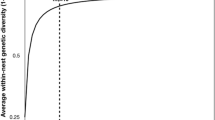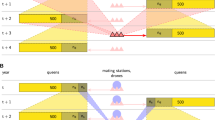Abstract
Multiple mating by honeybee queens results in colonies of genotypically diverse workers. Recent studies have demonstrated that increased genetic diversity within a honeybee colony increases the variation in the frequency of tasks performed by workers. We show that genotypically diverse colonies, each composed of 20 subfamilies, collect more pollen than do genotypically similar colonies, each composed of a single subfamily. However, genotypically similar colonies collect greater varieties of pollen than do genotypically diverse colonies. Further, the composition of collected pollen types is less similar among genotypically similar colonies than among genotypically diverse colonies. The response threshold model predicts that genotypic subsets of workers vary in their response to task stimuli. Consistent with this model, our findings suggest that genotypically diverse colonies likely send out fewer numbers of foragers that independently search for pollen sources (scouts) in response to protein demand by the colony, resulting in a lower variety of collected pollen types. The cooperative foraging strategy of honeybees involves a limited number of scouts monitoring the environment that then guide the majority of foragers to high quality food sources. The genetic composition of the colony appears to play an important role in the efficiency of this behavior.


Similar content being viewed by others
References
Beekman M, Gilchrist AL, Duncan M, Sumpter DJT (2007) What makes a honeybee scout? Behav Ecol Sociobiol 61:985–995
Beshers SN, Fewell JH (2001) Models of division of labor in social insects. Annu Rev Entomol 46:413–440
Boomsma JJ, Ratnieks FLW (1996) Paternity in eusocial hymenoptera. Philos Trans R Soc B Biol Sci 351:947–975
Bray JR, Curtis JT (1957) An ordination of the upland forest communities of Southern Wisconsin. Ecol Monogr 27(4):325–349
Calderone NW, Page RE (1988) Genotypic variability in age polyethism and task specialization in the honey bee, Apis mellifera (Hymenoptera: Apidae). Behav Ecol Sociobiol 22:17–25
Camazine S (1993) The regulation of pollen foraging by honey bees: how foragers assess the colony’s need for pollen. Behav Ecol Sociobiol 32:265–272
Campana BJ, Moeller FE (1977) Honey bees: preference for and nutritive value of pollen from five plant sources. J Econ Entomol 70:39–41
Cole BJ, Wiernasz DC (1999) The selective advantage of low relatedness. Science 285:891–893
Cook SM, Sandoz JC, Martin AP, Murray DA, Poppy GM, Williams IH (2005) Could learning of pollen odours by honey bees (Apis mellifera) play a role in their foraging behaviour? Physiol Entomol 30:164–174
Crozier RH, Fjerdingstad EJ (2001) Polyandry in social Hymenoptera—disunity or diversity? Ann Zool Fenn 38:267–285
Crozier RH, Page RE (1985) On being the right size: male contributions and multiple mating in social Hymenoptera. Behav Ecol Sociobiol 18:105–115
Dreller C (1998) Division of labor between scouts and recruits: genetic influence and mechanisms. Behav Ecol Sociobiol 43:191–196
Dreller C, Tarpy DR (2000) Perception of the pollen need by foragers in a honeybee colony. Anim Behav 59:91–96
Fewell JH, Page RE (1993) Genotypic variation in foraging responses to environmental stimuli by honey bees, Apis mellifera. Experientia 49:1106–1112
Fewell JH, Winston ML (1992) Colony state and regulation of pollen foraging in the honey bee, Apis mellifera L. Behav Ecol Sociobiol 30:387–393
Fuchs S, Schade V (1994) Lower performance in honeybee colonies of uniform paternity. Apidologie 25:155–168
Gotelli NJ, Entsminger GL (2009) EcoSim: null models software for ecology. Version 7. Acquired Intelligence Inc., Jericho. Available at http://garyentsminger.com/ecosim.htm
Gotelli NJ, Graves GR (1996) Null models in ecology. Smithsonian Books, Washington
Haberl M, Moritz RFA (1994) Estimation of intracolonial worker relationship in a honey bee colony (Apis mellifera L.) using DNA fingerprinting. Insect Soc 41:263–272
Hamilton WD (1964) The genetical evolution of social behaviour. J Theor Biol 7(1):1–52
Hamilton WD (1987) Kinship, recognition, disease, and intelligence: constraints of social evolution. In: Ito Y, Brown JL, Kikkawa J (eds) Animal societies: theory and facts. Japanese Scientific Society Press, Tokyo, pp 81–102
Hellmich RL, Kulincevic JM, Rothenbuhler WC (1985) Selection for high and low pollen-hoarding honey bees. J Hered 76:155–158
Hughes WO, Ratnieks FL, Oldroyd BP (2008) Multiple paternity or multiple queens: two routes to greater intracolonial genetic diversity in the eusocial Hymenoptera. Journal of Evolutionary Biology 21:1090–1095
Jennions MD, Petrie M (2000) Why do females mate multiply? A review of the genetic benefits. Biol Rev 75:21–64
Jones JC, Myerscough MR, Graham S, Oldroyd BP (2004) Honey bee nest thermoregulation: diversity promotes stability. Science 305:402–404
Kapp RO, Davis OK, King JE (2000) Guide to pollen and spores. American Association of Stratigraphic Palynologists, College Station
Keller L, Hudson KR (1994) Genetic variability, queen number, and polyandry in social Hymenoptera. Evolution 48:694–704
Kraus FB, Neumann P, Praagh J, Moritz RFA (2004) Sperm limitation and the evolution of extreme polyandry in honeybees (Apis mellifera L.). Behav Ecol Sociobiol 55(5):494–501
Laidlaw HH (1977) Instrumental insemination of honey bee queens. Dadant, Hamilton
Laidlaw HH, Page RE (1997) Queen rearing and bee breeding. Wicwas, Cheshire
Levin MD, Bohart GE (1955) Selection of pollens by honey bees. Am Bee J 95:392–393
Mattila HR, Seeley TD (2007) Genetic diversity in honey bee colonies enhances productivity and fitness. Science 317:362–364
Mattila HR, Seeley TD (2010) Promiscuous honeybee queens generate colonies with a critical minority of waggle-dancing foragers. Behav Ecol Sociobiol 64(5):875–889
Mattila HR, Burke KM, Seeley TD (2008) Genetic diversity within honeybee colonies increases signal production by waggle-dancing foragers. Proc R Soc B Biol Sci 275:809–816
Oldroyd BP, Thompson GJ (2007) Behavioural genetics of the honey bee, Apis mellifera. Adv Insect Physiol 33:1–49
Oldroyd BP, Clifton MJ, Parker K, Wongsiri S, Rinderer TE, Crozier RH (1998) Evolution of mating behavior in the genus Apis and an estimate of mating frequency in Apis cerana (Hymenoptera: Apidae). Ann Entomol Soc Am 91(5):700–709
Page RE, Robinson GE, Fondrk MK, Nasr ME (1995) Effects of worker genotypic diversity on honey bee colony development and behavior (Apis mellifera L.). Behav Ecol Sociobiol 36:387–396
Palmer KA, Oldroyd BP (2000) Evolution of multiple mating in the genus Apis. Apidologie 31:235–248
Pankiw T, Page RE, Fondrk KM (1998) Brood pheromone stimulates pollen foraging in honey bees (Apis mellifera). Behav Ecol Sociobiol 44(3):193–198
Pernal SF, Currie RW (2002) Discrimination and preferences for pollen-based cues by foraging honeybees, Apis mellifera L. Anim Behav 63:369–390
Ridley M (1988) Mating frequency and fecundity in insects. Biol Rev 63:509–549
Robinson GE, Huang ZY (1998) Colony integration in honey bees: genetic, endocrine, and social control of division of labor. Apidologie 29:159–170
Robinson GE, Page RE (1989) Genetic basis for division of labor in an insect society. In: Breed MD, Page RE (eds) The genetics of social evolution. Westview, Boulder, pp 61–80
Schlüns H, Moritz RFA, Neumann P, Kryger P, Koeniger G (2005) Multiple nuptial flights, sperm transfer and the evolution of extreme polyandry in honeybee queens. Anim Behav 70(1):125–131
Schmidt JO (1984) Feeding preferences of Apis mellifera L. (Hymenoptera: Apidae): individual versus mixed pollen species. J Kansas Entomol Soc 57:323–327
Seeley TD (1983) Division of labor between scouts and recruits in honeybee foraging. Behav Ecol Sociobiol 12:253–259
Seeley TD, Tarpy DR (2007) Queen promiscuity lowers disease within honeybee colonies. Proc R Soc B Biol Sci 274:67–72
Sherman PW, Seeley TD, Reeve HK (1988) Parasites, pathogens, and polyandry in social Hymenoptera. Am Nat 151:392–396
Somerville DC (2001) Nutritional value of bee collected pollens. Report DAN 134A. Rural Industries Research and Development Corporation
Standifer L (1967) A comparison of the protein quality of pollens for growth-stimulation of the hypopharyngeal glands and longevity of honey bees, Apis mellifera L. (Hymenoptera: Apidae). Insect Soc 14:415–425
Strassmann J (2001) The rarity of multiple mating by females in the social Hymenoptera. Insect Soc 48:1–13
Tarpy DR (2003) Genetic diversity within honeybee colonies prevents severe infections and promotes colony growth. Proc R Soc B Biol Sci 270(1510):99–103
Tarpy DR, Page RE (2002) Sex determination and the evolution of polyandry in honey bees (Apis mellifera). Behav Ecol Sociobiol 52:143–150
Tarpy DR, Seeley TD (2006) Lower disease infections in honeybee (Apis mellifera) colonies headed by polyandrous vs. monandrous queens. Naturwissenschaften 93:195–199
Visscher PK, Seeley TD (1982) Foraging strategy of honeybee colonies in a temperate deciduous forest. Ecology 63:1790–1801
Waller GD, Gary NE, Chester ST Jr, Karim MS, Martin JH, Vaissiere BE (1985) Honeybee colony populations and foraging rates on onion seed-fields in Arizona. J Apic Res 24:93–101
Woyciechowski M, Warakomska Z (1994) Worker’s genetic diversity has no relation to pollen diversity in a honey bee colony (Apis mellifera L.). J Ethol 12:163–167
Zar JH (1999) Biostatistical analysis. Prentice Hall, Inc., Upper Saddle River
Acknowledgements
We are grateful to Tom Glenn for producing the instrumentally inseminated queens and to John Jones for identification of pollen grains. Thanks also to Ruben Alarcon for statistical guidance and to Mona Chambers, Morgan Caseman, Delayne Caseman, and Maurisa Two Two for help with the bees. Linda Eckholm, Tim Griffith, and two anonymous reviewers provided helpful comments that greatly improved the manuscript. This experiment complied with current guidelines and regulations concerning subject handling. The authors declare that they have no conflicts of interest.
Author information
Authors and Affiliations
Corresponding author
Additional information
Communicated by R. Moritz
Electronic supplementary material
Below is the link to the electronic supplementary material.
Online Resource 1
Identification and frequencies of pollen types collected by honey bee colonies between 19-Aug-2008 and 17-Sep-2008 in Tucson, Arizona USA. Sampling periods 1, 2, and 3 occurred from 19-Aug-2008 to 28-Aug-2008, 29-Aug-2008 to 07-Sep-2008, and 08-Sep-2008 to 17-Sep-2008, respectively. Pollen types were identified via 500-grain pollen count using light microscopy. Samples were collected from each colony at the end of each sampling period.(XLS 46 kb)
Rights and permissions
About this article
Cite this article
Eckholm, B.J., Anderson, K.E., Weiss, M. et al. Intracolonial genetic diversity in honeybee (Apis mellifera) colonies increases pollen foraging efficiency. Behav Ecol Sociobiol 65, 1037–1044 (2011). https://doi.org/10.1007/s00265-010-1108-8
Received:
Revised:
Accepted:
Published:
Issue Date:
DOI: https://doi.org/10.1007/s00265-010-1108-8




